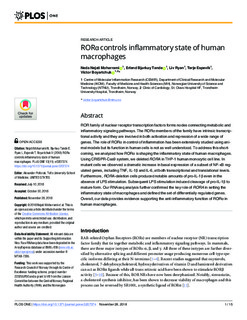| dc.contributor.author | Nejati Moharrami, Neda | |
| dc.contributor.author | Tande, Erlend Bjørkøy | |
| dc.contributor.author | Ryan, Liv | |
| dc.contributor.author | Espevik, Terje | |
| dc.contributor.author | Boyartchuk, Victor | |
| dc.date.accessioned | 2019-02-26T14:51:29Z | |
| dc.date.available | 2019-02-26T14:51:29Z | |
| dc.date.created | 2018-11-28T20:54:07Z | |
| dc.date.issued | 2018 | |
| dc.identifier.citation | PLoS ONE. 2018, 13 (11), . | nb_NO |
| dc.identifier.issn | 1932-6203 | |
| dc.identifier.uri | http://hdl.handle.net/11250/2587613 | |
| dc.description.abstract | ROR family of nuclear receptor transcription factors forms nodes connecting metabolic and inflammatory signaling pathways. The RORα members of the family have intrinsic transcriptional activity and they are involved in both activation and repression of a wide range of genes. The role of RORα in control of inflammation has been extensively studied using animal models but its function in human cells is not as well understood. To address this shortcoming, we analyzed how RORα is shaping the inflammatory state of human macrophages. Using CRISPR-Cas9 system, we deleted RORA in THP-1 human monocytic cell line. In mutant cells we observed a dramatic increase in basal expression of a subset of NF-κB regulated genes, including TNF, IL-1β and IL-6, at both transcriptional and translational levels. Furthermore, RORA-deletion cells produced notable amounts of pro-IL-1β even in the absence of LPS stimulation. Subsequent LPS stimulation induced cleavage of pro-IL-1β to mature form. Our RNAseq analysis further confirmed the key role of RORA in setting the inflammatory state of macrophages and defined the set of differentially regulated genes. Overall, our data provides evidence supporting the anti-inflammatory function of RORα in human macrophages. | nb_NO |
| dc.language.iso | eng | nb_NO |
| dc.publisher | Public Library of Science | nb_NO |
| dc.rights | Navngivelse 4.0 Internasjonal | * |
| dc.rights.uri | http://creativecommons.org/licenses/by/4.0/deed.no | * |
| dc.title | RORα controls inflammatory state of human macrophages | nb_NO |
| dc.type | Journal article | nb_NO |
| dc.type | Peer reviewed | nb_NO |
| dc.description.version | publishedVersion | nb_NO |
| dc.source.pagenumber | 15 | nb_NO |
| dc.source.volume | 13 | nb_NO |
| dc.source.journal | PLoS ONE | nb_NO |
| dc.source.issue | 11 | nb_NO |
| dc.identifier.doi | 10.1371/journal.pone.0207374 | |
| dc.identifier.cristin | 1636614 | |
| dc.description.localcode | © 2018 Nejati Moharrami et al. This is an open access article distributed under the terms of the Creative Commons Attribution License, which permits unrestricted use, distribution, and reproduction in any medium, provided the original author and source are credited. | nb_NO |
| cristin.unitcode | 194,65,15,0 | |
| cristin.unitcode | 194,65,1,0 | |
| cristin.unitname | Institutt for klinisk og molekylær medisin | |
| cristin.unitname | MH fakultetsadministrasjon | |
| cristin.ispublished | true | |
| cristin.fulltext | original | |
| cristin.qualitycode | 1 | |

